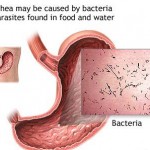Gastroenteritis (also known as gastric flu, stomach flu, and stomach virus, although unrelated to influenza) is marked by severe inflammation of the gastrointestinal tract involving both the stomach and small intestine resulting in acute diarrhea and vomiting. It can be transferred by contact with contaminated food and water. The inflammation is caused most often by an infection from certain viruses or less often by bacteria, their toxins (e.g. SEB), parasites, or an adverse reaction to something in the diet or medication.
At least 50% of cases of gastroenteritis resulting from foodborne illness are caused by norovirus. Another 20% of cases, and the majority of severe cases in children, are due to rotavirus. Other significant viral agents include adenovirus and astrovirus.
Risk factors include consumption of improperly prepared foods or contaminated water and travel or residence in areas of poor sanitation. It is also common for river swimmers to become infected during times of rain as a result of contaminated runoff water.
Symptoms and signs
 Gastroenteritis often involves stomach pain or spasms, diarrhea and/or vomiting, with noninflammatory infection of the upper small bowel, or inflammatory infections of the colon.
Gastroenteritis often involves stomach pain or spasms, diarrhea and/or vomiting, with noninflammatory infection of the upper small bowel, or inflammatory infections of the colon.
The condition is usually of acute onset, normally lasting 1–6 days, and is self-limiting.
- Nausea and vomiting
- Diarrhea
- Dehydration
- Fever
- Abnormal flatulence
- Abdominal cramps
- Bloody stools (dysentery – suggesting infection by amoeba, Campylobacter, Salmonella, Shigella or some pathogenic strains of Escherichia coli)
- Heartburn
The main contributing factors include poor feeding in infants. Diarrhea is common, and may be followed by vomiting. Viral diarrhea usually causes frequent watery stools, whereas blood stained diarrhea may be indicative of bacterial colitis. In some cases, even when the stomach is empty, bile can be vomited up.
A child with mild or moderate dehydration may have a prolonged capillary refill, poor skin turgor and abnormal breathing.
Cause
Bacterial
 Different species of pathogenic bacteria can cause gastroenteritis, including Salmonella, Shigella, Staphylococcus,Campylobacter jejuni, Clostridium, Escherichia coli, Yersinia, Vibrio cholerae, and others. Some sources of the infection are improperly prepared food, reheated meat dishes, seafood, dairy, and bakery products. Each organism causes slightly different symptoms but all result in diarrhea. Colitis, inflammation of the large intestine, may also be present. Such pathogenic enteric bacteria are generally distinguished from the usually harmless bacteria of the normal gut flora, but the distinction is often not fully clear, and Escherichia, for example, can belong to either group.
Different species of pathogenic bacteria can cause gastroenteritis, including Salmonella, Shigella, Staphylococcus,Campylobacter jejuni, Clostridium, Escherichia coli, Yersinia, Vibrio cholerae, and others. Some sources of the infection are improperly prepared food, reheated meat dishes, seafood, dairy, and bakery products. Each organism causes slightly different symptoms but all result in diarrhea. Colitis, inflammation of the large intestine, may also be present. Such pathogenic enteric bacteria are generally distinguished from the usually harmless bacteria of the normal gut flora, but the distinction is often not fully clear, and Escherichia, for example, can belong to either group.
Pseudomembranous colitis is an important cause of diarrhea in patients often recently treated with broad-spectrum antibiotics. Traveler’s diarrhea is usually a type of bacterial gastroenteritis.
If gastroenteritis in a child is severe enough to require admission to a hospital, then it is important to distinguish between bacterial and viral infections. Bacteria like Shigella and Campylobacter, and parasites like Giardia can be treated with antibiotics.
Viral
Viruses causing gastroenteritis include rotavirus, norovirus, adenovirus and astrovirus. Viruses do not respond to antibiotics and infected children usually make a full recovery after a few days. Children admitted to hospital with gastroenteritis routinely are tested for rotavirus A to gather surveillance data relevant to the epidemiological effects of rotavirus vaccination programs. These children are routinely tested also for norovirus, which is extraordinarily infectious and requires special isolation procedures to avoid transmission to other patients. Other methods, electron microscopy and polyacrylamide gel electrophoresis, are used in research laboratories.
A complete medical history may be helpful in diagnosing gastroenteritis. A complete and accurate medical history of the patient includes information on travel history, exposure to poisons or other irritants, diet change, food preparation habits or storage and medications. Patients who travel may be exposed to E. Coli infections or parasite infections contacted from beverages or food. Swimming in contaminated water or drinking from suspicious fresh water such as mountain streams or wells may indicate infection from Giardia – an organism found in water that causes diarrhea.
Food poisoning must be considered in cases when the patient was exposed to undercooked or improperly stored food. Depending on the type of bacteria that is causing the condition, the reactions appear in 2 to 72 hours. Detecting the specific infectious agent is required in order to establish a proper diagnosis and an effective treatment plan.
The doctor may want to find whether the patient has been using broad-spectrum or multiple antibiotics in their recent past. If so, they could be the cause of an irritation of the gastrointestinal tract.
During the physical examination, the doctor will look for other possible causes of the infection. Conditions such as appendicitis, gallbladder disease, pancreatitis or diverticulitis may cause similar symptoms but a physical examination will reveal a specific tenderness in the abdomen which is not present in gastroenteritis.
Diagnosing gastroenteritis is mainly an exclusion procedure. Therefore in rare cases when the symptoms are not enough to diagnose gastroenteritis, several tests may be performed in order to rule out other gastrointestinal disorders. These include rectal examinations, complete blood count, electrolytes and kidney function tests. However, when the symptoms are conclusive, no tests apart from the stool tests are required to correctly diagnose gastroenteritis especially if the patient has traveled to at-risk areas.

